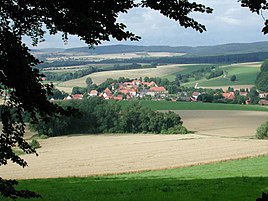Westerhof
|
Westerhof
Kalefeld municipality
|
||
|---|---|---|
| Coordinates: 51 ° 46 ′ 0 ″ N , 10 ° 7 ′ 0 ″ E | ||
| Height : | 165 m above sea level NN | |
| Residents : | 499 (Aug 31, 2017) | |
| Incorporation : | March 1, 1974 | |
| Postal code : | 37589 | |
| Area code : | 05553 | |
|
Location of Westerhof in Lower Saxony |
||
|
Westerhof, seen from the Koppenberg
|
||
Westerhof is part of the Kalefeld community in the Northeim district in Lower Saxony .
Geographical location
Westerhof lies, framed on three sides by the Westerhöfer Wald and the Luhne , in a basin through which the floodplain flows.
history
The time of construction of Westerhof Castle and the beginning of settlement in the village of Westerhof are not known. According to tradition, the castle is said to have stood before "Caroli Magnis" ( Charlemagne ). The chronicler Johann Georg Leuckfeld claims in his "History of Blankenburg" an event in the year 841. After that, the Lords of Westerhof are said to have received the right to appoint the pastor in Holthusen ( Langenholtensen ). After this family died out, the right passed to the Wiebrechtshausen monastery . In 1351, in a document from the Wiebrechtshausen monastery, the Lords of Westerhof are named as patrons of the Wiebrechtshausen monastery church and liege lords of the Langenholtensen church.
Westerhof was first documented on March 26th, 1190. Conradus de Westerhoue sold four Hufen land (approx. 120 ha) and ten farms in Elze to the Lamspringe monastery so that his daughter Rixa could join the convent there. In the 13th century, members of the Westerhof family were often named in documents as buyers, sellers and witnesses. The seal of Henricus de Westerhoue (State Archives Hanover), which is still used today as the local coat of arms of the village of Westerhof, is from this time (1255).
1294 was first mentioned in documents of the "Castrum Westerhoue", the castle Westerhof. In 1302 the previous owners, the Lords of Oldershausen , sold Westerhof Castle for 1020 marks with the free county and extensive sovereignty to the Hildesheim Bishop Siegfried II of Querfurt . The sale created a new political situation in the Westerhof area. The diocese of Hildesheim set up a new administrative unit, from which the "Westerhof Office" later emerged. In the centuries that followed, Westerhof Castle was a constant subject of lien until the Lords of Oldershausen became the sole lien holders due to financial difficulties in the diocese in 1519. As a result of the Hildesheim collegiate feud , the castle was given all rights to the Guelphs in 1523 . From this point on it belongs to the Duchy of Braunschweig-Lüneburg and was administered by an official . Until 1859 the castle was the seat of the bailiff in the old Westerhof office .
Westerhof was incorporated into the municipality of Kalefeld on March 1, 1974.
politics
Since the 2011 election, the Westerhof local council has consisted of three members of the SPD and four members of the CDU (2011 election).
Economy and Infrastructure
Employers in Westerhof for around 40 full-time and 20 part-time jobs are four craft businesses, an industrial company for assembly technology, an engineering office, a forestry company, an event company, a company for music and lottery machines and a branch of the monastery forestry office. Other economic institutions are a travel agency and a restaurant. There are five full-time farms in agriculture.
traffic
The Westerhof station was on the Osterode – Kreiensen railway line . This is shut down.
Culture and sights
Attractions
- Altes Spritzenhaus - permanent exhibition of old fire fighting equipment
- Heimatstube - permanent exhibition of the Heimatverein in the Westerhof meeting point on the history of agriculture and handicrafts in the village
- Chapel of Ortisei
Club life
There are 10 clubs in Westerhof, including sports, skat and home clubs. In addition, there is a choir, a local SPD association, a hunting association, a local DRK association and the Westerhof volunteer fire brigade , which provides fire protection and general help, especially at the local level.
literature
- Horst Bredthauer: History of the Westerhof Castle. in: Westerhöfer yearbook 1994
Individual evidence
- ^ Federal Statistical Office (ed.): Historical municipality directory for the Federal Republic of Germany. Name, border and key number changes in municipalities, counties and administrative districts from May 27, 1970 to December 31, 1982 . W. Kohlhammer GmbH, Stuttgart and Mainz 1983, ISBN 3-17-003263-1 , p. 216 .




